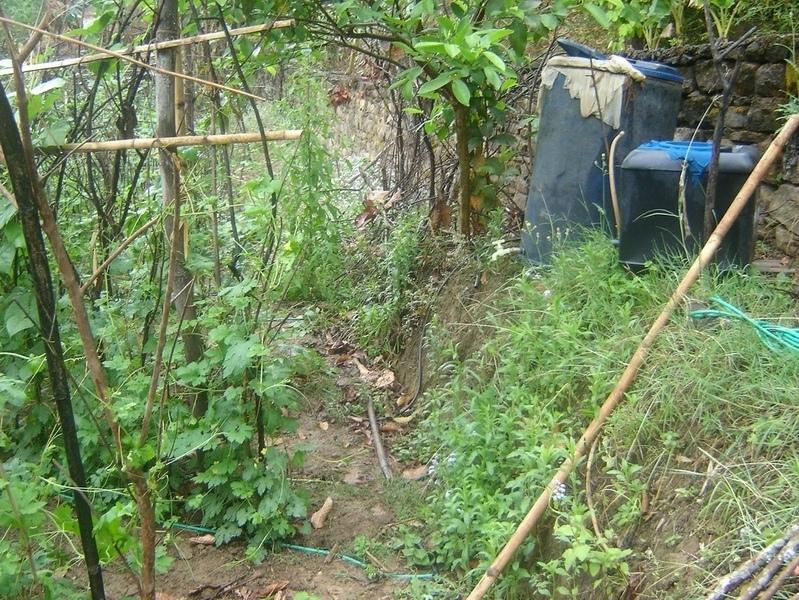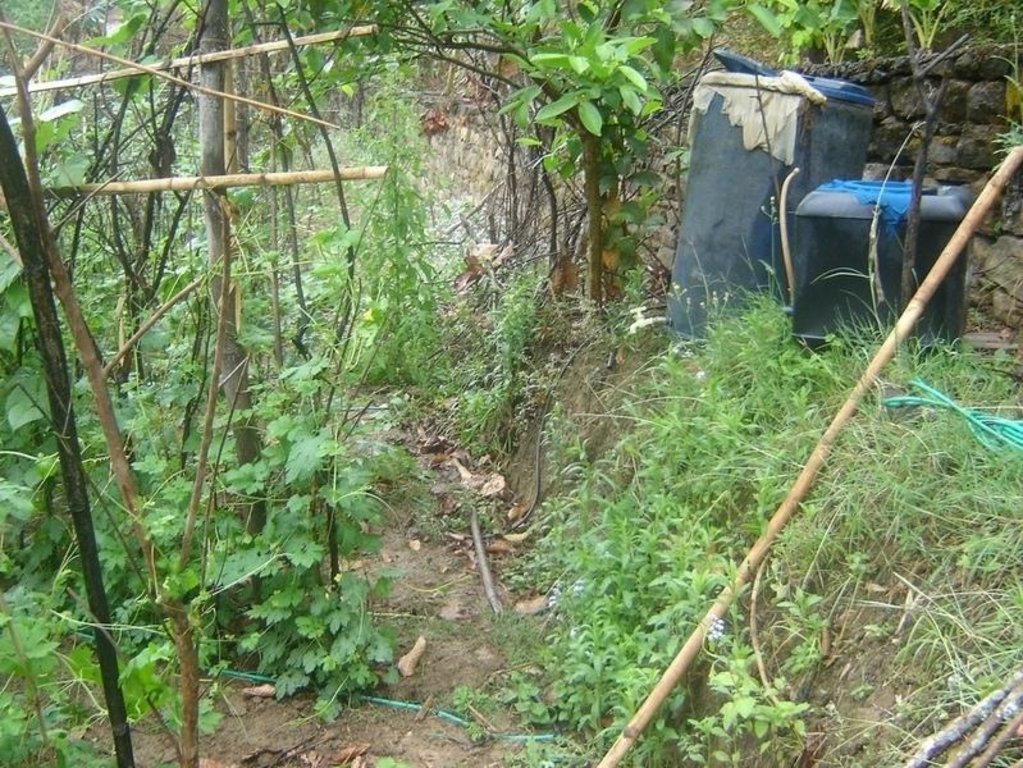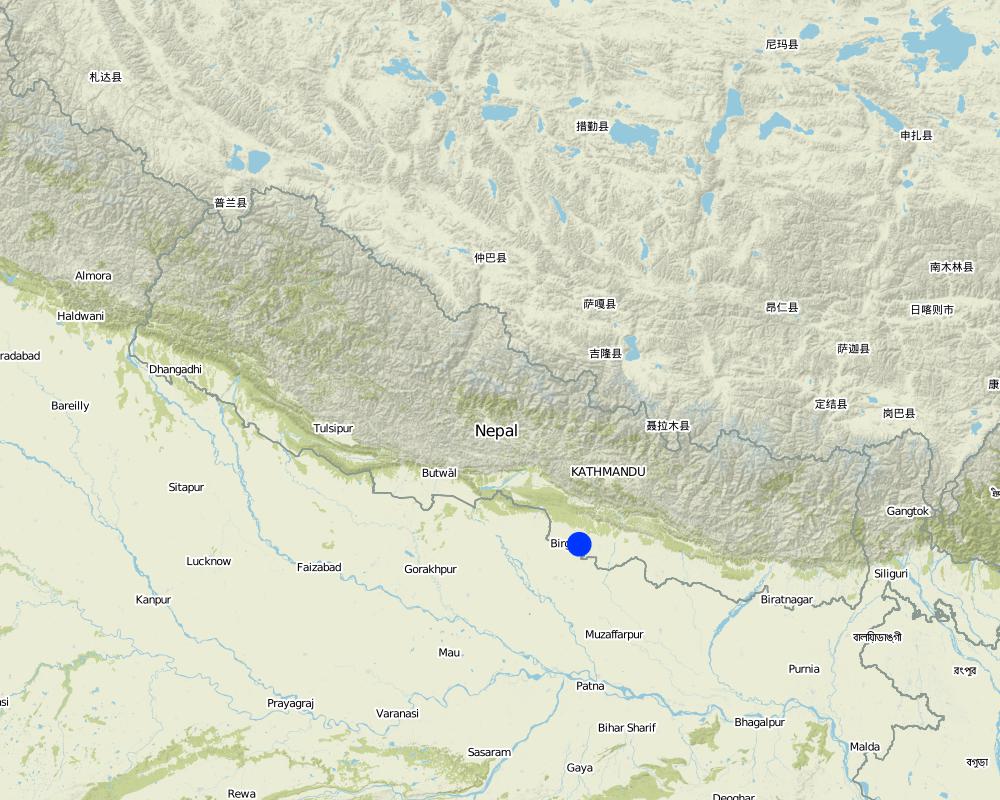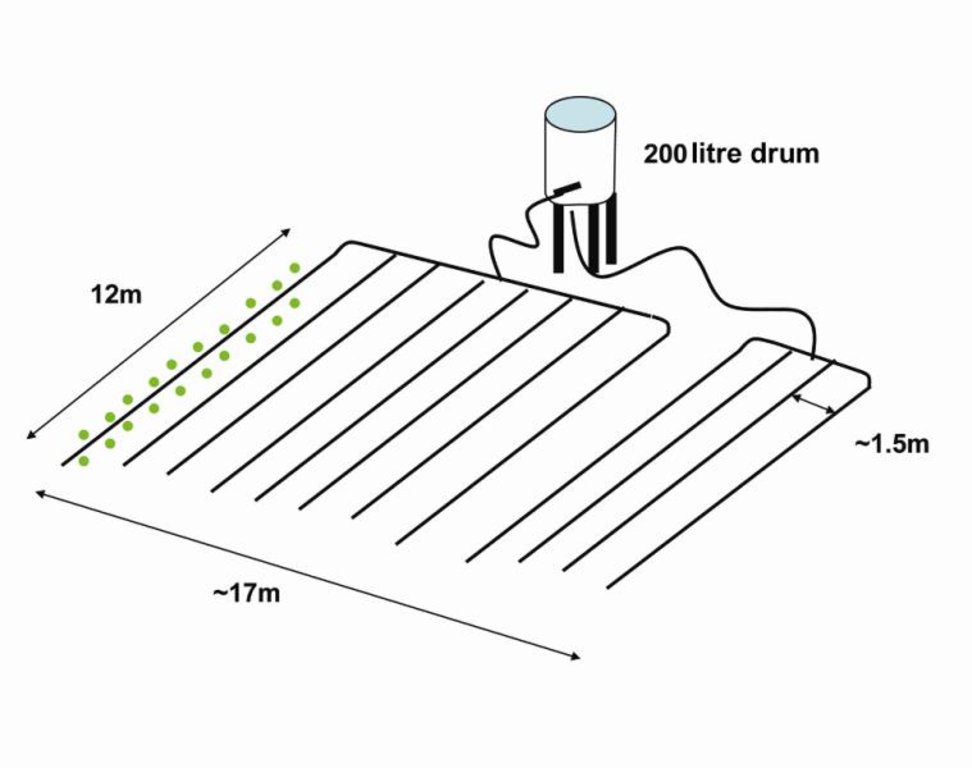Urine application through drip irrigation for bitter gourd production [Népal]
- Création :
- Mise à jour :
- Compilateur : Richard Allen
- Rédacteur : –
- Examinateurs : David Streiff, Alexandra Gavilano
Karela kheti ma thopa sinchai ko satha ma pasu mutra ko prayog (Nepali)
technologies_1751 - Népal
Voir les sections
Développer tout Réduire tout1. Informations générales
1.2 Coordonnées des personnes-ressources et des institutions impliquées dans l'évaluation et la documentation de la Technologie
Spécialiste GDT:
Director
Soil Management Directorate, Department of Agriculture
Népal
Spécialiste GDT:
Team Leader
Sustainable Soil Management Programme
Népal
Nom du projet qui a facilité la documentation/ l'évaluation de la Technologie (si pertinent)
Sustainable Soil Management Programme, Nepal (SSMP)Nom du ou des institutions qui ont facilité la documentation/ l'évaluation de la Technologie (si pertinent)
Department of Agriculture, Soil Management Directorate, Hariharbhawan Lalitpur (doasoil) - NépalNom du ou des institutions qui ont facilité la documentation/ l'évaluation de la Technologie (si pertinent)
HELVETAS (Swiss Intercooperation)1.3 Conditions relatives à l'utilisation par WOCAT des données documentées
Le compilateur et la(les) personne(s) ressource(s) acceptent les conditions relatives à l'utilisation par WOCAT des données documentées:
Oui
1.5 Référence au(x) Questionnaires sur les Approches de GDT (documentées au moyen de WOCAT)

Farmer field schools on integrated plant nutrient systems [Népal]
Participatory and collaborative learning through the farmer field school approach
- Compilateur : Richard Allen

Farmer-to-farmer diffusion [Népal]
Wider diffusion of sustainable soil management technologies through a demand responsive farmer-to-farmer diffusion approach
- Compilateur : Richard Allen
2. Description de la Technologie de GDT
2.1 Courte description de la Technologie
Définition de la Technologie:
Application of cattle urine through drip irrigation technology to provide constant flow of fertiliser to bitter gourd
2.2 Description détaillée de la Technologie
Description:
Bitter gourd vegetables fetch a high price in the off-season and respond well if grown with drip irrigation. This crop is planted in December/January and harvested from May through to July/August. The growing period mainly falls in the driest period of the year and therefore requires irrigation.
In addition to water, the plants need fertiliser to ensure healthy growth and good production. Nitrogen is the most important macronutrient for plants and high crop productivity can only be achieved if sufficient nitrogen is available. Nitrogen is also the most limiting nutrient in most areas of Nepal’s midhills. Traditionally farmers applied farmyard manure; but in many places this is being supplemented or entirely replaced by inorganic fertiliser, mainly urea. However, fertiliser prices have increased substantially in recent years and this type of fertiliser is often not available in sufficient quantities in areas away from the roadheads. At the same time cultivation practices are intensifying with greater cropping intensities and more nutrient demanding crops as local varieties are replaced by hybrids and new crops are introduced. This can easily lead to nutrient mining and soil fertility decline unless there is an equivalent increase in inorganic or mineral fertilisation.
Cattle urine is a viable alternative to mineral fertiliser; it is nitrogen rich. The urine is collected in improved cattle sheds (fact sheet on urine collection QT NEP1). For constant fertiliser application and to reduce the water requirement, the collected urine can be added to the irrigation water in the drip irrigation tanks (fertigation). Farmers who have tried this say it has increased the yield of bitter gourd and other cash crops, in some cases by as much as 100%. Other crops that can be grown using drip irrigation with a water-urine mixture are cauliflower, cucumber, and other types of gourd.
2.3 Photos de la Technologie
2.5 Pays/ région/ lieux où la Technologie a été appliquée et qui sont couverts par cette évaluation
Pays:
Népal
Autres spécifications du lieu:
Midhills districts of Nepal
Spécifiez la diffusion de la Technologie:
- répartie uniformément sur une zone
Map
×3. Classification de la Technologie de GDT
3.1 Principal(aux) objectif(s) de la Technologie
- améliorer la production
3.2 Type(s) actuel(s) d'utilisation des terres, là où la Technologie est appliquée

Terres cultivées
- Cultures annuelles
Cultures annuelles - Précisez les cultures:
- légumes - melon, citrouille, courge ou cucurbitacées
Commentaires:
Major land use problems (compiler’s opinion): Intensifying cultivation practices with either 1) inadequate application of fertilisers leading to a decline in soil fertility and the mining of soil nutrients or 2) application of too much fertiliser causing environmental problems through excessive leaching, and losses of fertiliser in surface runoff and consequent eutrophication or nitrification of streams, ponds, or groundwater. Also, irrigation water is in short supply during 6 to 8 months of the year. Fertigation allows about 20 to 30% of the irrigation water to be replaced by urine.
3.5 Groupe de GDT auquel appartient la Technologie
- gestion intégrée de la fertilité des sols
3.6 Mesures de GDT constituant la Technologie

modes de gestion
- M2: Changement du niveau de gestion / d'intensification
3.7 Principaux types de dégradation des terres traités par la Technologie

dégradation chimique des sols
- Cn: baisse de la fertilité des sols et réduction du niveau de matière organique (non causée par l’érosion)
3.8 Prévention, réduction de la dégradation ou réhabilitation des terres dégradées
Spécifiez l'objectif de la Technologie au regard de la dégradation des terres:
- réduire la dégradation des terres
4. Spécifications techniques, activités, intrants et coûts de mise en œuvre
4.1 Dessin technique de la Technologie
Spécifications techniques (associées au dessin technique):
The following setup was used in Iman Singh Basnet’s fi eld:
- two drip irrigation sets: one set with
8 lines, one with 4 lines
- a 200 l plastic drum
- 20 bitter gourd plants per line with
1.5m spacing between lines
- approximate area covered: 200m2
Note that the drum was not delivered with the drip irrigation set. Mr Basnet uses the same drum for irrigating other crops where drip irrigation is not feasible, in which case he connects a pipe with a rose to the drum.
Technical knowledge required for field staff / advisors: low
Technical knowledge required for land users: low
Main technical functions: supplementary irrigation, constant and slow supply of nutrients, increase in soil fertility & increase in soil productivity
Secondary technical functions: pest control
4.2 Informations générales sur le calcul des intrants et des coûts
Spécifiez la manière dont les coûts et les intrants ont été calculés:
- par entité de la Technologie
Précisez l'unité:
Drip irrigation system
Précisez les dimensions de l'unité de terrain (le cas échéant):
200 l plastic drum; 20 bitter gourd plants per line with 1.5m spacing between lines
Indiquez la monnaie utilisée pour le calcul des coûts:
- dollars américains
Indiquez le coût salarial moyen de la main d'œuvre par jour:
2.00
4.3 Activités de mise en place/ d'établissement
| Activité | Calendrier des activités (saisonnier) | |
|---|---|---|
| 1. | Prepare and place stakes | |
| 2. | Collect urine (see WOCAT fact sheet ‘Improved cattle shed for improved urine collection – QT NEP1) | |
| 3. | Grow bitter gourd seedlings | |
| 4. | Set up drip irrigation set and prepare field | |
| 5. | Transplant seedlings |
4.4 Coûts et intrants nécessaires à la mise en place
| Spécifiez les intrants | Unité | Quantité | Coûts par unité | Coût total par intrant | % du coût supporté par les exploitants des terres | |
|---|---|---|---|---|---|---|
| Main d'œuvre | Collect urine and prepare irrigation system | persons/unit | 2,0 | 2,0 | 4,0 | 100,0 |
| Equipements | Drip set | unit | 1,0 | 36,0 | 36,0 | 100,0 |
| Equipements | Drum | unit | 1,0 | 4,0 | 4,0 | 100,0 |
| Matériaux de construction | Stakes | unit | 1,0 | 6,0 | 6,0 | 100,0 |
| Coût total de mise en place de la Technologie | 50,0 | |||||
| Coût total de mise en place de la Technologie en dollars américains (USD) | 50,0 | |||||
Commentaires:
Duration of establishment phase: 1 month(s)
4.5 Activités d'entretien/ récurrentes
| Activité | Calendrier/ fréquence | |
|---|---|---|
| 1. | Clear drip holes | |
| 2. | Double filter the urine – once when taking out of the collection tank, and again when pouring into the drip irrigation tank | |
| 3. | Irrigate every alternate day with 160 l water and 40 l urine. | |
| 4. | Fix shoots to the stakes | |
| 5. | Raise ridges for better irrigation efficiency | |
| 6. | Harvest the crop |
4.6 Coûts et intrants nécessaires aux activités d'entretien/ récurrentes (par an)
| Spécifiez les intrants | Unité | Quantité | Coûts par unité | Coût total par intrant | % du coût supporté par les exploitants des terres | |
|---|---|---|---|---|---|---|
| Main d'œuvre | Maintain drip irrigatio nsystem and apply urine | persons/unit | 15,0 | 2,0 | 30,0 | 100,0 |
| Coût total d'entretien de la Technologie | 30,0 | |||||
| Coût total d'entretien de la Technologie en dollars américains (USD) | 30,0 | |||||
Commentaires:
Cost calculated in January 2007.
5. Environnement naturel et humain
5.1 Climat
Précipitations annuelles
- < 250 mm
- 251-500 mm
- 501-750 mm
- 751-1000 mm
- 1001-1500 mm
- 1501-2000 mm
- 2001-3000 mm
- 3001-4000 mm
- > 4000 mm
Zone agro-climatique
- humide
Thermal climate class: subtropics
5.2 Topographie
Pentes moyennes:
- plat (0-2 %)
- faible (3-5%)
- modéré (6-10%)
- onduleux (11-15%)
- vallonné (16-30%)
- raide (31-60%)
- très raide (>60%)
Reliefs:
- plateaux/ plaines
- crêtes
- flancs/ pentes de montagne
- flancs/ pentes de colline
- piémonts/ glacis (bas de pente)
- fonds de vallée/bas-fonds
Zones altitudinales:
- 0-100 m
- 101-500 m
- 501-1000 m
- 1001-1500 m
- 1501-2000 m
- 2001-2500 m
- 2501-3000 m
- 3001-4000 m
- > 4000 m
Commentaires et précisions supplémentaires sur la topographie:
Landforms: Also valley floors
5.6 Caractéristiques des exploitants des terres appliquant la Technologie
Orientation du système de production:
- subsistance (auto-approvisionnement)
- commercial/ de marché
Individus ou groupes:
- individu/ ménage
Indiquez toute autre caractéristique pertinente des exploitants des terres:
Off-farm income specification: In most farm households, off-farm income plays at least a minor and increasingly a major role. Occasional opportunities for off-farm income present themselves in the form of daily labour wages. Some households’ members receive regular salaries, whilst an increasing number of Nepalis are working in India, the Middle East, Malaysia, and elsewhere and sending remittance incomes home.
5.7 Superficie moyenne des terres utilisées par les exploitants des terres appliquant la Technologie
- < 0,5 ha
- 0,5-1 ha
- 1-2 ha
- 2-5 ha
- 5-15 ha
- 15-50 ha
- 50-100 ha
- 100-500 ha
- 500-1 000 ha
- 1 000-10 000 ha
- > 10 000 ha
5.8 Propriété foncière, droits d’utilisation des terres et de l'eau
Propriété foncière:
- individu, sans titre de propriété
Droits d’utilisation des terres:
- loué
- individuel
6. Impacts et conclusions
6.1 Impacts sur site que la Technologie a montrés
Impacts socio-économiques
Production
production agricole
Revenus et coûts
dépenses pour les intrants agricoles
Commentaires/ spécifiez:
reduced expenses for agrochemicals (fertilisers, pesticides)
Autres impacts socio-économiques
Allows organic production of high value crops
establishment costs
Impacts socioculturels
social prestige as a progressive farmer
requires handling of dung and urine
Impacts écologiques
Autres impacts écologiques
application of agrochemicals (fertilisers, pesticides)
eutrophication, nitrification of water bodies due to uncontrolled outflow of urine
6.2 Impacts hors site que la Technologie a montrés
pollution des rivières/ nappes phréatiques
Commentaires/ spécifiez:
reduced influx of nutrients into water bodies
dependence on costly external inputs
6.4 Analyse coûts-bénéfices
Quels sont les bénéfices comparativement aux coûts de mise en place (du point de vue des exploitants des terres)?
Rentabilité à court terme:
positive
Rentabilité à long terme:
positive
Quels sont les bénéfices comparativement aux coûts d'entretien récurrents (du point de vue des exploitants des terres)?
Rentabilité à court terme:
positive
Rentabilité à long terme:
positive
Commentaires:
The high cost of mineral fertiliser and the high price that bitter gourd fetches means that the establishment costs are soon recovered. In the long-term, a major reduction in fertiliser costs and improved income leads to increased benefits.
6.5 Adoption de la Technologie
- cas isolés/ expérimentaux
De tous ceux qui ont adopté la Technologie, combien d'entre eux l'ont fait spontanément, à savoir sans recevoir aucune incitation matérielle, ou aucune rémunération? :
- 91-100%
Commentaires:
Comments on spontaneous adoption: Some farmers in Surkhet district started to use the technology in 2006, after seeing Iman Singh Basnet's innovation of applying urine through drip irrigation in 2005.
6.7 Points forts/ avantages/ possibilités de la Technologie
| Points forts/ avantages/ possibilités du point de vue du compilateur ou d'une autre personne ressource clé |
|---|
|
Urine as a liquid manure is applied at the same time as irrigation (fertigation) How can they be sustained / enhanced? The link between urine application and drip irrigation or other forms of small scale irrigation needs to be promoted |
|
The on-farm use of collected urine reduced the need for mineral fertiliser thereby reducing cash expenditure and outside dependency How can they be sustained / enhanced? Further promote the technology to increase this impact |
|
Human urine can also be used, but needs to be fermented longer and may be socially less acceptable How can they be sustained / enhanced? Further promote the use of urine and show that there is no problem with using human urine |
6.8 Faiblesses/ inconvénients/ risques de la Technologie et moyens de les surmonter
| Faiblesses/ inconvénients/ risques du point de vue du compilateur ou d'une autre personne ressource clé | Comment peuvent-ils être surmontés? |
|---|---|
| The initial establishment costs for a drip irrigation set may hinder adoption |
Prepare a business plan and calculate the cost-benefi t to convince farmers of the technology’s benefi ts |
| Lack of availability of urine may inhibit the commercial application of urine with drip irrigation | Urine needs to be established as a tradeable good produced by livestock farmers and bought by vegetable farmers to apply to their crops |
7. Références et liens
7.1 Méthodes/ sources d'information
Liens et modules
Développer tout Réduire toutLiens

Farmer field schools on integrated plant nutrient systems [Népal]
Participatory and collaborative learning through the farmer field school approach
- Compilateur : Richard Allen

Farmer-to-farmer diffusion [Népal]
Wider diffusion of sustainable soil management technologies through a demand responsive farmer-to-farmer diffusion approach
- Compilateur : Richard Allen
Modules
Aucun module trouvé





